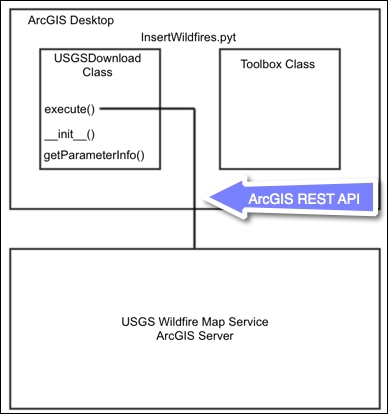Before we start building the application, we'll spend some time planning what we'll build. This is a fairly simple application, but it serves to illustrate how ArcGIS Desktop and ArcGIS Server can be easily integrated using the ArcGIS REST API. In this application, we'll build an ArcGIS Python Toolbox that serves as a container for a single tool called USGSDownload. The USGSDownload tool will use the Python requests, JavaScript Object Notation (JSON), and ArcPy da modules to request real-time wildfire data from a USGS map service. The response from the map service will contain information including the location of the fire, the name of the fire, and some additional information that will then be written to a local geodatabase.
The communication between the ArcGIS Desktop Python Toolbox and the ArcGIS Server map service will be accomplished through the ArcGIS REST API and the Python language.

Let's get started and build the application.



